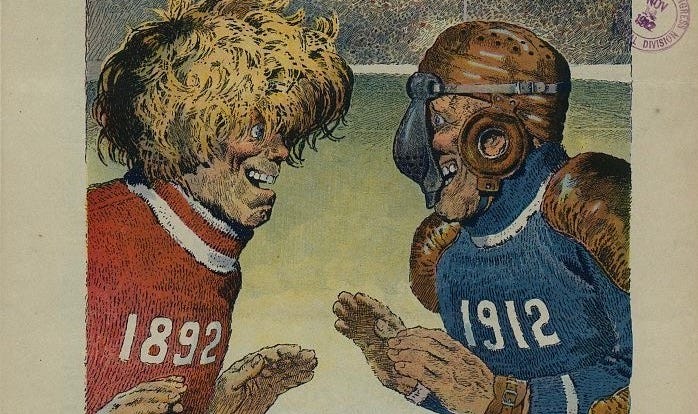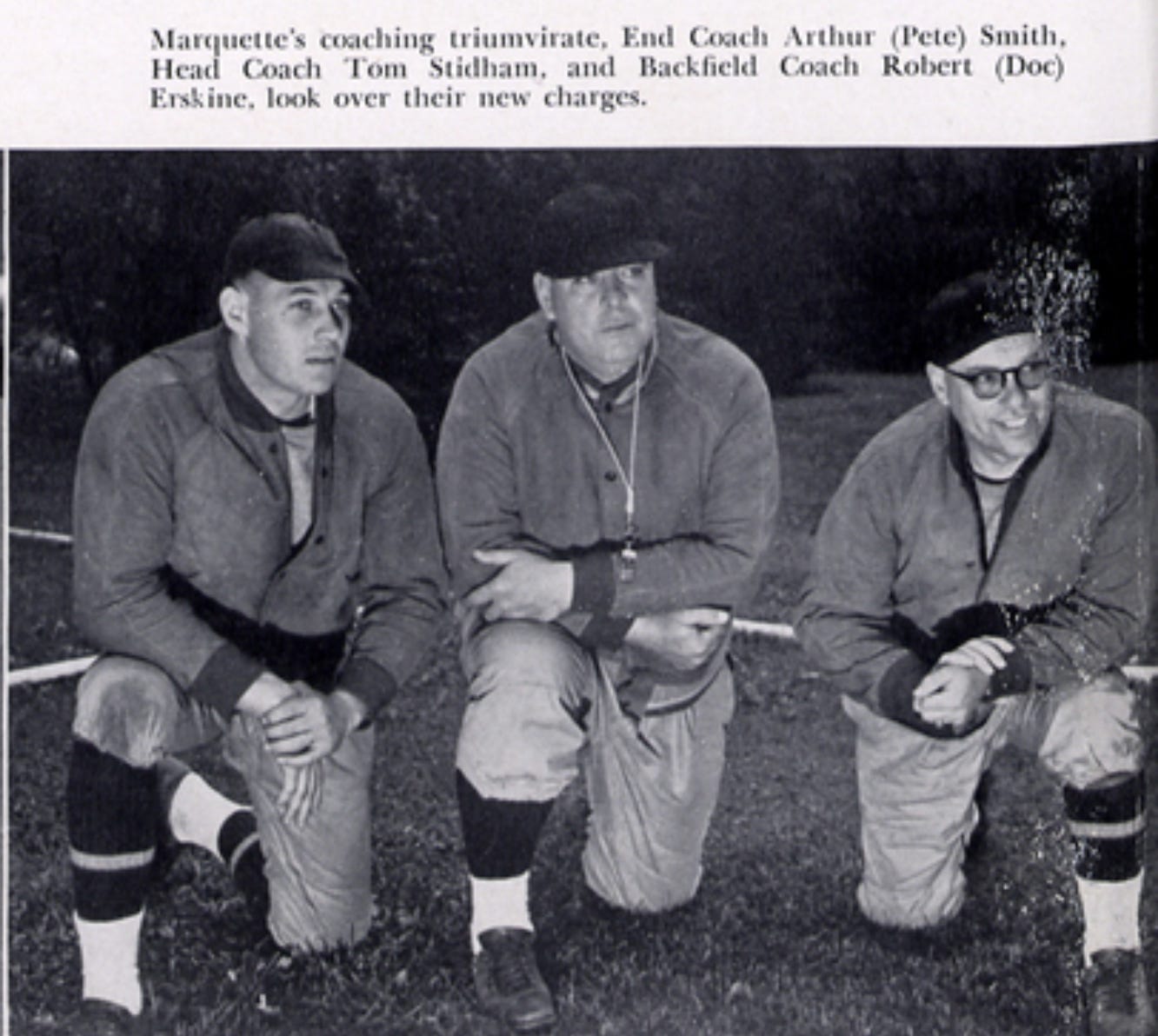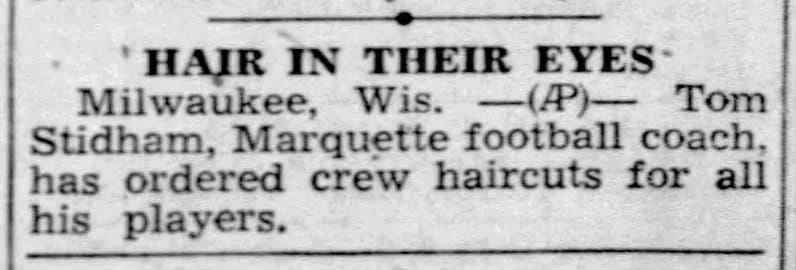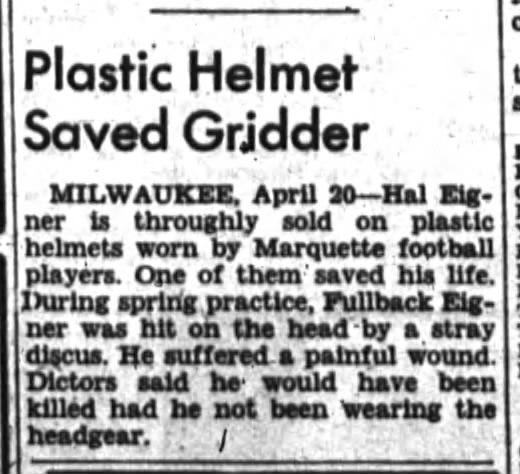Today's Tidbit... Marquette and Hairbrained Football
Harebrained thinking is considered foolish, crazy, or unlikely to succeed. While the term has been around for about 500 years, Marquette University showed harebrained and hairbrained thinking in the early 1940s when Harold "Hal" Eigner played quarterback and fullback for the Hilltoppers.
Before football players wore helmets or other protective headgear, it was common practice to grow their hair long to protect themselves from the blowing wind and blows to the head.
The arrival of early headgear, more solid leather helmets, and then plastic helmets ended the need for long hair on the field, but some players chose to let their hair grow to be fashionable. That seems to have been the case with Hal Eigner, a hometown Milwaukeean who played varsity football for Marquette from 1941 through 1943.
Eigner was a quarterback in 1941 before shifting to fullback later in the season. He held that position over the next two years and was among the team's leading scorers. What makes Eigner unique is the press coverage of two hair-related incidents and a third in which his helmet likely saved his life.
Like today, the media in the 1940s loved short little stories that filled open space in a column, so those tales got picked up nationwide. The first story hit the news in October 1941, Eigner's sophomore year. He played quarterback early in the season, and as he called signals during practice, his hair sometimes fell into his eyes, causing him to brush it away. (The team likely did not wear helmets when running their signal drills against air.) Backfield coach Robert "Doc" Erskine wanted Eigner to keep his hands in the game and threatened to cut Eigner's hair if the practice continued.
Unfortunately for Eigner and his beautiful locks, Coach Erskine brought a pair of scissors to practice one day. When Eigner's hair fell into his eyes, Erskine used those scissors to cut the offending locks on the field. Coaches may be unable to get away with cutting hair without a license nowadays, but that did not stop them in 1941.
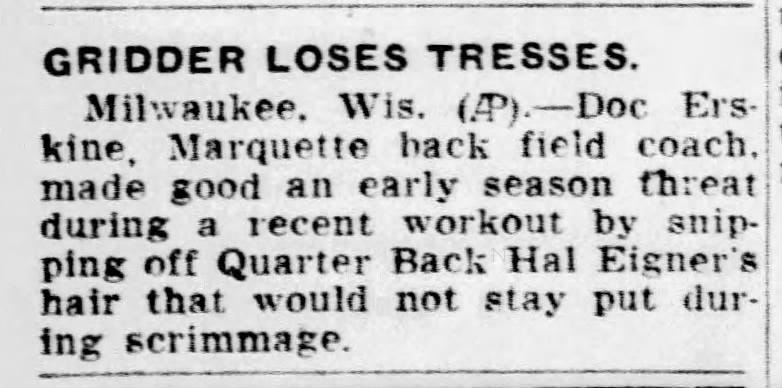

Marquette football made national news in 1942 for another hair-raising event—or, more accurately, a hair-shortening event. This time, head coach Tom Stidham decided one day that his team's hair was getting in the way of practice, so he ordered the entire team to get crew cuts, and it appears they complied.
The third event that raised Eigner's profile came during spring practice in 1942. Marquette Stadium hosted the school's football and track teams, and Eigner was a member of both since he was one of the Midwest's top quarter-milers. One spring day, Eigner was on the field practicing with the football team while track practice was underway.
As mentioned in previous articles, plastic football helmets debuted in 1940 when Northwestern wore Riddell's new invention in their season opener against Syracuse. A few schools acquired plastic helmets before plastic was declared a war commodity, and the U.S. Army adopted a version of Riddell’s helmet for paratrooper training.
Marquette was one of the lucky schools to acquire a full set of plastic helmets, as seen in their 1941 football team picture.

How do Marquette’s plastic helmets relate to stories about Eigner and his hair? Well, Eigner was wearing his fancy helmet during that spring practice, so they must not have been running signal drills. It is unclear whether Eigner was standing around or moving about the field, but one of his track and field teammates let a discus fly, and the darn thing flew toward Eigner and struck him squarely in the head. While injured by the discus, had Marquette not obtained plastic helmets and Eigner not been wearing his during practice that day, he likely would have been killed. (There are plenty of newspaper stories of people being struck by disci, some fatally, though Eigner is the only one I found who was wearing a plastic football helmet at the time.)
Eigner appears to have recovered without ill effects since he played two more years of varsity football for Marquette. Whether Eigner's helmet survived the incident is another story, but it probably increased Riddell's helmet sales while the Tenite plastic remained available.
Eigner, who was in the Naval Reserve at Marquette, finished his senior season, graduated in Chemical Engineering, and lived long enough to attend Marquette's homecoming in 1961. I'm guessing he told the discus story that weekend and on many other occasions throughout his life. I would, too.
Football Archaeology is reader-supported. Click here to buy one of my books or otherwise support the site.


